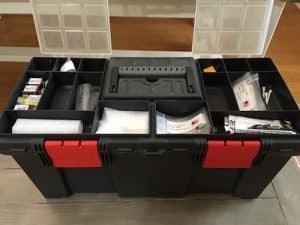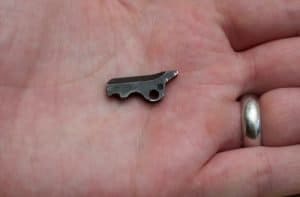Firearms are some of the most important tools that a prepper owns. They can help you defend your family and put food on the table. Unfortunately, guns are mechanical devices and may fail. Because of this, it is a good idea to build a firearms spare parts kit to keep your guns running and in good shape.
Extra Magazines

The first thing you should buy when creating a spare parts kit for your firearms is extra magazines. There are a couple of reasons for this. The first one is that magazines will likely be the first thing to get hit by new laws and regulations. Several states have already passed such laws. The other reason to have spare magazines is that they tend to wear out or get lost.
Magazines suffer a lot of abuse, especially during training drills and competitions. During firearm courses and competitions, magazines get flung out of the gun and hit the ground. This sort of treatment is hard on something made out of relatively thin sheet metal.
You cannot have too many magazines for your pistols and rifles. However, I do recommend having a minimum number for any firearm you own. For pistols, I try to have at least seven full-capacity magazines for each of my pistols. If you have a rifle, such as an AR-15 or AK-47, having at least ten magazines is a good start. However, if you are able to stock more than this, go for it.
You can find a wide selection of magazines at Brownells.com by clicking here.
It is much easier to build a supply of spare magazines if you have similar firearms. For example, I am able to use the magazines from my full-size CZ in my compact CZ. Although the compact magazines won’t fit in the full-size gun, having parts commonality gives me a ton of mags that will fit in the compact. This saves me money and helps me stay organized.
Magazine Parts to Store
Base Plate: If any part of your magazine is going to break, it will most likely be the base plate. They suffer a lot of damage during reload drills and bumps from everyday use. However, base plates are usually easy to replace, especially if you use a popular firearm with aftermarket support. You may even be able to purchase base plates that will extend your magazine’s capacity.
Magazine Springs: Over time, magazine springs may become weak due to use. When springs become weak, you may start to experience feeding issues. If your firearm feeds reliably with all magazines but one, and that magazine doesn’t have any obvious signs of physical damage, it may be the spring. You can find replacement springs from Brownells, Midway USA, and Wolff Gun Springs.
Followers: Another good part to have on hand to keep your magazines in working order is the follower. This is the part of the magazine that rests on top of the spring and pushes the rounds up. Since most of them are plastic, they may get chewed up over time.
Spare Parts for All Firearms
This is a list of spare parts that you should have on hand, regardless of what kind of gun or guns you own. These are, generally speaking, the parts that are most likely to break or get lost and require replacement. Have a couple of these parts for each firearm you plan on using during a long-term emergency situation or for personal defense.
Parts Container

If you are building a spare parts kit for your guns, you need a good container to keep them organized. My gunsmithing toolbox has compartments on top of the lid that allow me to easily organize parts.
Small parts organizers produced by companies such as Dewalt and Milwaukee are excellent choices as well. These feature several compartments but don’t take up too much space.
If you want to keep your spare parts at your workbench, small drawer organizers would fit your needs nicely. I use one to store my old gun parts in case I need them for reference or in case I need to use them in the gun again.
Books and Videos
Sometimes looking at a firearm’s internals can feel like you are looking into the human brain. Unless you have a ton of experience, figuring out what each part does and how to remove it and get it back in there is next to impossible. Because of this, you will need good reference materials if you are going to work on your own firearms. Without them, you won’t have a clue how to use your spare parts.
If I need to perform a repair or parts replacement on one of my firearms, I like to watch videos of it being done. As of right now, Youtube is still a good source for disassembly and reassembly videos for almost any firearm you can imagine. Aside from Youtube, the American Gunsmithing Institute produces videos that detail disassembly, reassembly, and cleaning procedures for several types of firearms. They are a little dated, but the information contained in them is still relevant for the firearms they cover.
Books are excellent sources of information for home gunsmiths. Many manufacturers sell armorer’s manuals to the public. These are much more detailed than the user’s manual that comes with most guns. Other good books include The Official NRA Guide to Firearms Assembly and firearm-specific books such as Gunsmithing The AR-15 by Patrick Sweeney.
Extractors

Unless you want every gun you own to be a single-shot firearm, you need to keep some spare extractors on hand. Claws on extractors have a tendency to break, sort of like a fingernail. Fortunately, most of them are fairly easy to replace when using an appropriately-sized punch and a slave pin. Just don’t lose the spring.
Pins
Firearms use pins to hold springs and other small parts in place. Some pins, like the extractor pin on AR-15’s, are very easy to lose while cleaning. Others, like some firing pin retaining pins, are subjected to a lot of wear during use.
Because of this, it is a good idea to keep a supply of pins for your guns in your spare parts kit, especially small ones and those which are removed during cleaning. Some pins you need to include in your firearms spare parts kit include but may not be limited to the following:
- Firing pin retaining pins
- Trigger pins
- Hammer pins
- Sear pins
Screws
Screws are another type of fastener used to hold firearms together. Unfortunately, it is almost impossible to find a replacement gun screw at your local hardware store. Because of this, you want to keep screws for your guns in your spare parts kit. Here are some examples of screws you will need to keep on hand.
- Assembly screws
- Although most modern firearms are mostly held together with pins, they do still have some screws. An example is the grip screw inside of an AR rifle’s pistol grip. Revolvers, especially single-action ones, have a ton of screws.
- Scope ring screws
- If your gun has a scope or other type of optic, be sure to have extra scope ring screws in your spare parts kit. These can strip out or become lost when replacing scopes. If you can find them the right length and thread pitches, Torx-head screws are a good choice. The heads on these are far less likely to strip out than Phillips or Allen head screws.
- Handguard screws
- If you have a handguard on your rifle that is held on with screws, keep a couple of extra screws on hand in case they wander out while firing.
*Note: If you notice that a particular screw becomes loose while firing, apply Blue Loctite to the threads. This will help prevent it from walking out in the future.
Springs
Springs are some of the most likely parts to break on a firearm. Because of their small size, they are also likely to get lost. Here are some springs you may want to include in a spare parts kit for your guns.
- Hammer springs
- This is the spring that gives the hammer the force it needs to strike the firing pin and detonate the primer. The way it looks will depend on the type of firearm you are dealing with. A weak hammer spring may be to blame if you are having consistent problems with light strikes.
- Striker Spring
- This type of spring is found in striker-fired handguns as well as some bolt action rifles. As with the hammer springs described above, replacing this part may help reduce or eliminate light strikes.
- Firing pin springs
- A firing pin spring is what allows a firing pin to retract after the gun is fired.
- Sear springs
- A sear spring is a part that allows the sear to catch on the hammer’s notches. It is a vital part of your gun’s firing mechanism.
- Trigger return springs
- As you pull your gun’s trigger, it moves towards the rear of the firearm. The trigger return spring or trigger reset spring, pushes the trigger back towards the front of the firearm. This allows you to fire again, without having to reset the trigger manually. Many pistols use a “torsion” spring for this and some have a tendency to break.
- Buffer springs
- The most obvious example of a buffer spring is the large spring found inside the buffer tube of AR-style rifles.
*Note: Modifications and repairs to a firearm’s firing mechanism (sear, sear spring, hammer, etc.) should only be attempted by skilled armorers and gunsmiths. Messing something up with one of these parts may make the firearm unsafe.
Batteries
If your firearm uses any electronic accessories, such as lights, lasers, or optics, be sure that you have spare batteries on hand. Some devices use special batteries that can be difficult to find, so plan ahead and keep a supply on hand.
Spare Parts for Pistols and Revolvers
Slide Stop or Locking Block

A common weak point on various types of semi-automatic pistols is the slide stop or locking block. Because of this, you need to keep one or two of them in your spare parts kit for your firearms. Which one you have will depend on the type of pistol you own. More traditional firearms, such as 1911’s, Browning Hi-Power’s, and CZ-75’s, have a slide stop that connects the slide, barrel, and frame together. Striker-fired pistols, such as Glock’s have a locking block instead.
The slide stop or locking block in your pistol is subjected to tremendous forces every time that the gun fires. It is not uncommon for slide stops to snap in half and locking blocks to crack. Because of this, it is a very important part to keep on hand and know how to replace.
*Note: A good way to reduce the chance of a slide stop or locking block failing is to replace your recoil spring with a new factory one every couple thousand rounds.
Recoil Spring
Another good thing to keep in your guns’ spare parts kit is a replacement recoil spring for your pistol(s). It is a good idea to have at least two or three on hand for each of your pistols. As stated above, replacing this part regularly will reduce the chance of a slide stop or locking block failing.
Replacing your pistol’s recoil spring has other benefits as well. A fresh spring will ensure that the firearm’s frame isn’t subjected to additional strain. It will also help ensure reliable extraction and reduce felt recoil compared to a weak and worn out spring.
Recoil Spring Guide Rod
The recoil spring guide rod is the part that the recoil spring fits over. On many firearms, it is made of plastic and may wear out over time.
Grips and Grip Screws
If your pistol or revolver has grip panels, it is a good idea to keep an extra set in your spare parts kit. Decorative grip panels, especially those made of wood, may crack if you accidentally drop the gun.
It is also a good idea to have an extra set of grip panel screws for your handgun. During firing, these may “walk out” and become lost.
Spare Parts for Rifles and Shotguns
Bolts
If you have an AR-style rifle, it is a good idea to keep a spare bolt on hand. Before you use a replacement bolt, check to make sure that it is properly headspaced. Headspacing, in a nutshell, is the spacing relationship between the bolt face and chamber and how the bullet fits between them. Bad headspacing can be dangerous, so use headspacing gauges to make sure your new bolt is up to spec.
Recoil Pads
If you have a high-recoil rifle or shotgun, it is a good idea to keep recoil pads in your spare parts kit. While most recoil pads are custom-fitted, slip on recoil pads are commonly available. They aren’t as nice or convenient as a fitted recoil pad, but they could save your shoulder.
Sling
Unless you want to carry your gun at all times, you need a good sling. While a good-quality sling should last several years, having a spare is never a bad idea.
Sling Swivels
A sling is not going to do you any good if you don’t have a way to install it onto your gun. Keep a couple of sets of sling swivels for your long guns in your spare parts kit. If you use quick-release sling mounts, be sure to have a backup for them as well.
Where to Find Spare Parts for Your Guns
Spare parts for your guns shouldn’t be too hard to find, as long as you know where to look. Many manufacturers will sell parts directly to customers from their website. Other online vendors such as Brownells and Midway USA sell parts as well.
Many local gun shops and even some sporting goods retailers sell parts kits for AR rifles. If you shoot a pistol used in competitions, such as Glocks, you may be able to find custom shops that will sell parts directly. While many produce their own special parts, some still offer factory replacement parts as well.
If you need to find parts for an older firearm, gunpartscorp.com is an excellent resource for this. I have used them a couple of times for parts and had good experiences.
Conclusion
Even if you can’t collect all of these spare parts for each of your guns, it is still a good idea to stock the ones you can. Prioritize the parts that are most likely to break or get lost. To do this, do an internet search for the most commonly broken parts for your specific firearm.
In order to make repairs on your guns the right way, you will need the right tools. Click on the links below to check out my gunsmithing tool articles. They are filled with useful information to help you select the right tools to make working on your guns easier and keep them in good shape.
Essential Gunsmithing Tools
Cheap Tools to Make Gunsmithing Easier
Brownell’s Magna-Tip Screwdriver Set Review
Complete Guide to Gunsmithing Punches
Essential Gun Cleaning Tools
How to Clean a Semi-Automatic Pistol
How to Repair a Damaged Gun Screw
Ruger 10/22 Sight Removal and Replacement
Essential Reloading Equipment: Introduction to Reloading
Disclaimers
Firearms are precision instruments that are subjected to immense forces and release tremendous amounts of energy when fired. As such, you must be extremely careful when making repairs or modifications to any firearm. If you are not qualified to do so, then don’t. Make sure that you fully understand what you are doing before you do any work on a firearm. You alone are responsible for any accidents or injuries that may occur due to your repairs or modifications as well as any legal troubles that may result. Be smart and be careful. Also, make sure that you do not break any laws by making illegal modifications to your firearms
